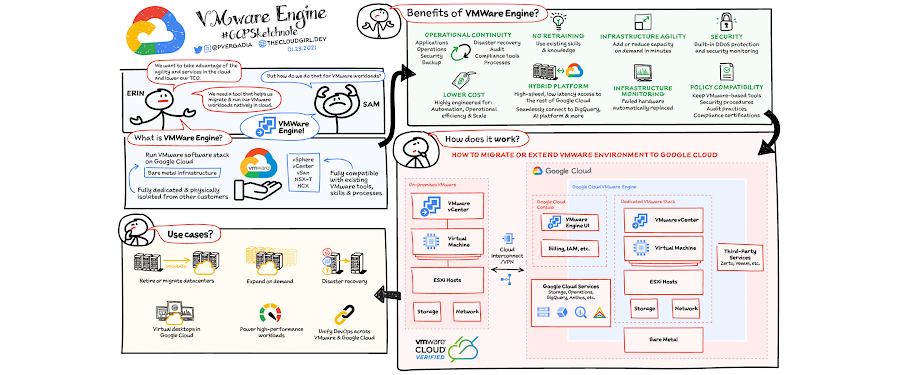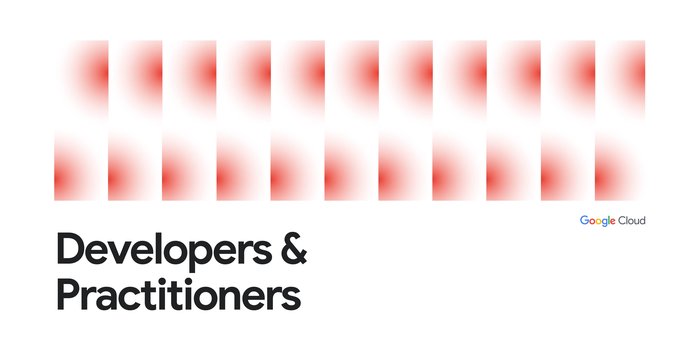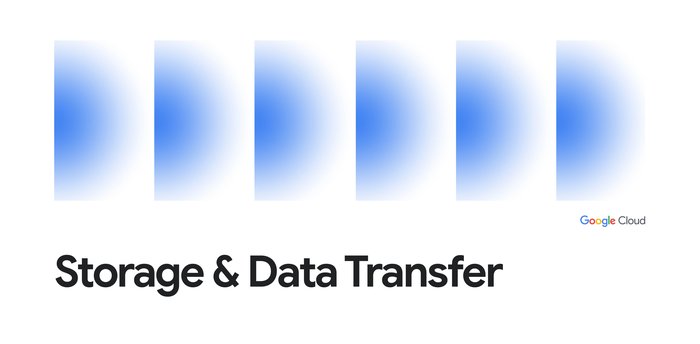A handy new Google Cloud, AWS, and Azure product map
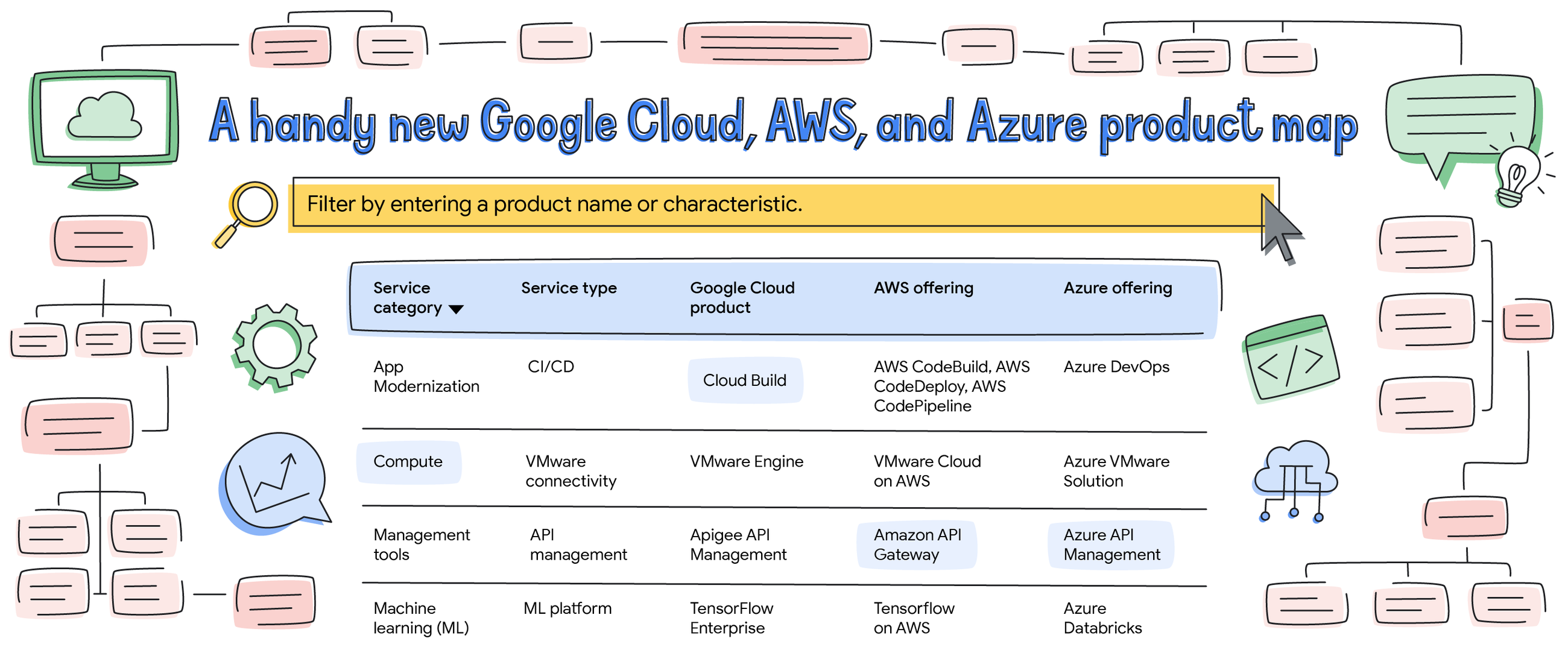
Stephanie Wong
Head of Developer Skills & Community, Google Cloud
Any craftsman will tell you that choosing the right tool for the job is essential for getting it done right. Cloud technologies are no different. Many cloud professionals look for the best products across vendors, but they remember ‘best’ is always subjective. It depends on highly-individualized criteria like language support, compatibility with existing tools, portability/openness, and cost. For others, the reality is as simple as choosing a product based on their team’s skill set and their existing tech stack. I understand that choice, since it’s much easier to learn how to use a new tool than to get people to change a process or domain knowledge.
Teams often seek to match tools to their process. They may start by asking: Are we a cloud-native, Kubernetes shop? Do we only program in Go, Python, or Java and want a better serverless hosting solution? Are we .NET all the way? Or, are we looking for the best stream data processing compatible with a managed Hadoop service?
No matter what the decision, choosing can be critical, optimally with a full understanding of what tools are available, how they relate to each other, and what similar offerings exist. Your experience with one provider or another is another factor, along with your long-range plan to incorporate such things as new security strategies, better automation, or artificial intelligence.
While you might not know every product mapping across providers, you probably have the foundational knowledge to understand which product categories are the most relevant to you, whether that’s managed Kubernetes, block storage, API management, or messaging services.
A new product map for side-by-side comparisons

Google continuously aims to organize the world's information and make it universally accessible and useful. That's why we just published a handy product map showcasing similar offerings between Google Cloud, AWS, and Azure. You can easily filter the list by product name or other common keywords. The hope is that this table can make it easier for you to quickly find similar products from each provider. You decide which product makes sense for your landscape and can best match your skills or goals.
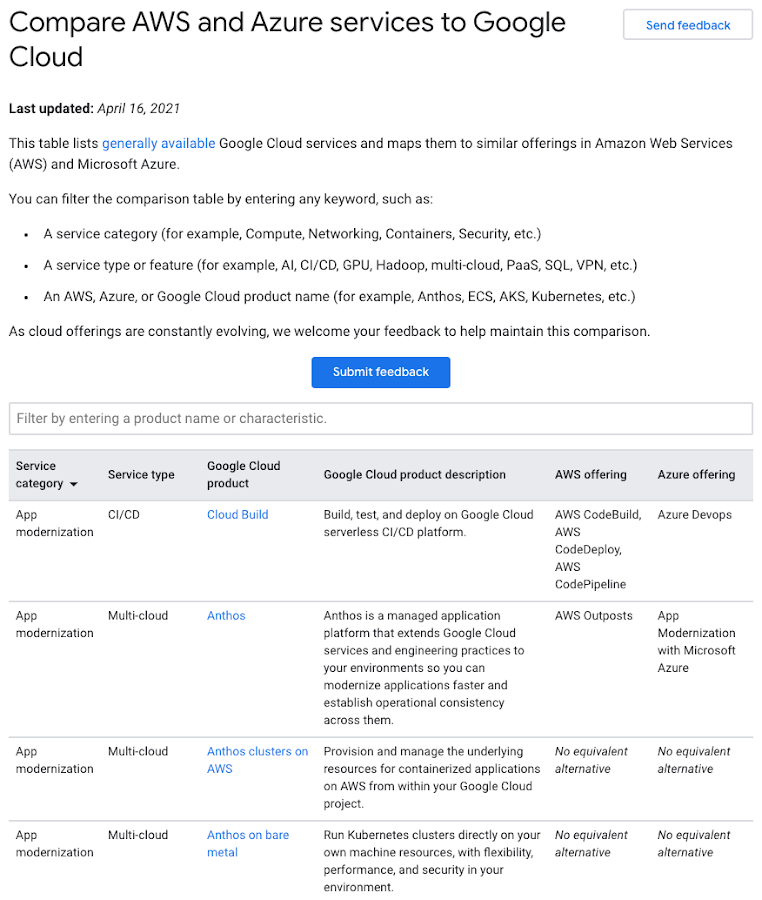

One thing this comparison makes evident is how much Google Cloud’s product offerings have grown and diversified in recent years. For example, Anthos, our managed application platform for application modernization, hybrid, and multicloud, has matured quickly, and now includes support for products for running on AWS, Azure, Bare Metal, and VMWare.
We have also been recognized in recent Gartner reports, in which Google was named a Leader in the 2020 Gartner Magic Quadrant for Cloud Infrastructure and Platform Services and in the 2021 Gartner Magic Quadrant for Cloud AI Developer Services. Meanwhile Forrester named Google as a Leader in The Forrester Wave(TM): Public Cloud Development And Infrastructure Platforms, North America, Q1 2020.
How to get more out of your cloud infrastructure
Because cloud providers work to differentiate their offerings, no two products are ever exactly the same. But many products do share a lot in common. If you search for the names of AWS or Azure products you already know and love, you may find a Google Cloud offering better tailored to your needs. If you are already using Google Cloud, you may find new Google Cloud products and capabilities you haven’t yet encountered.
The only advice I have is to dig in a little deeper when something catches your eye. Anthos, for example, is a managed application platform allowing you to modernize applications faster and establish operational consistency across them using Google Cloud services and engineering best practices. Beyond that, you’ll learn that Anthos is a suite of products that enables you to run Kubernetes clusters anywhere, in cloud and on-premises, and on bare metal servers. It also offers automated policy and security using Anthos Config Management, and a fully-managed service mesh with built-in visibility.
Filters are always a good idea
You can also filter by product name, characteristic, or keyword, for example, “compute”, “containers”, “CI/CD”, “SQL”, “Kubernetes”, or “no equivalent”.
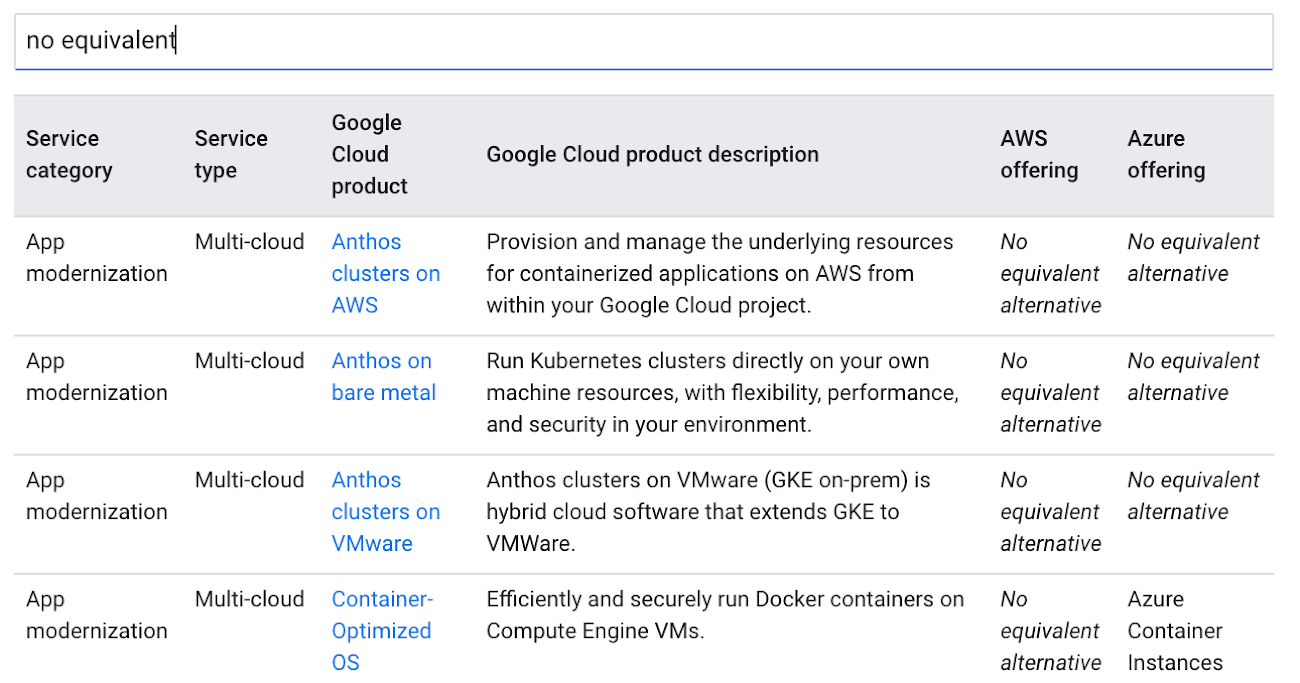

Some Google Cloud services are listed without any equivalent product mappings in AWS or Azure. This includes Anthos clusters on AWS, Anthos on bare metal, Anthos clusters on VMWare, Network Intelligence Center, Network Service Tiers, VPC Service Controls, Google Analytics, and Firebase Performance Monitoring. This doesn’t mean these are Google Cloud’s only unique products, but it does point out a few areas where the AWS and Azure portfolio differ. By clicking on linked product pages, you can discover more details around a product’s supported languages, APIs, design, and underlying infrastructure to determine how they compare to AWS and Azure’s options.


You might notice multiple entries for products whose features map to more than one AWS or Azure offering. For example, the Google Cloud SDK includes tools and libraries for interacting with many of our products and services, and maps to both AWS CLI and AWS SDKs. You’ll find Pub/Sub, our messaging and ingestion product for event-driven systems and streaming analytics, which can map to Amazon SNS, SGQS, or Kinesis.
We hope this comparison helps you evaluate and get started on Google Cloud. Our philosophy is that developers should have the freedom to run their applications in any cloud and environment to support their existing environment, skills, and requirements. Our job is to give you the information and tools to streamline your decision-making process, experimentation/testing, and ability to get up and running quickly.
Other handy resources
As they say, the best way to get started is to kick the tires, so get started on Google Cloud using a free trial. You can come in and test your projects out for free with $300 in credit with access to 20+products, and 100+ Marketplace free trials.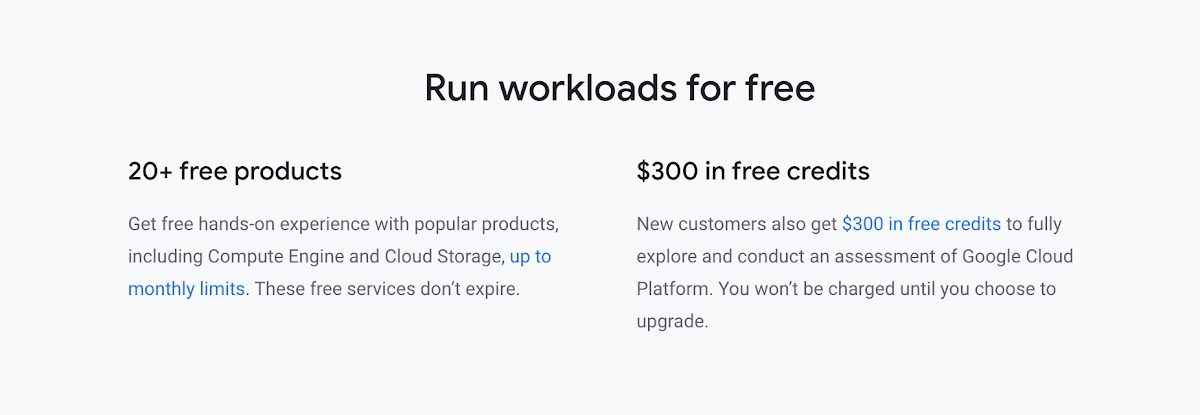

If you want a quick way to understand every Google Cloud product and service, check out our dictionary describing each one in 4 words or less, and well as our videos series explaining each in under 2 minutes.
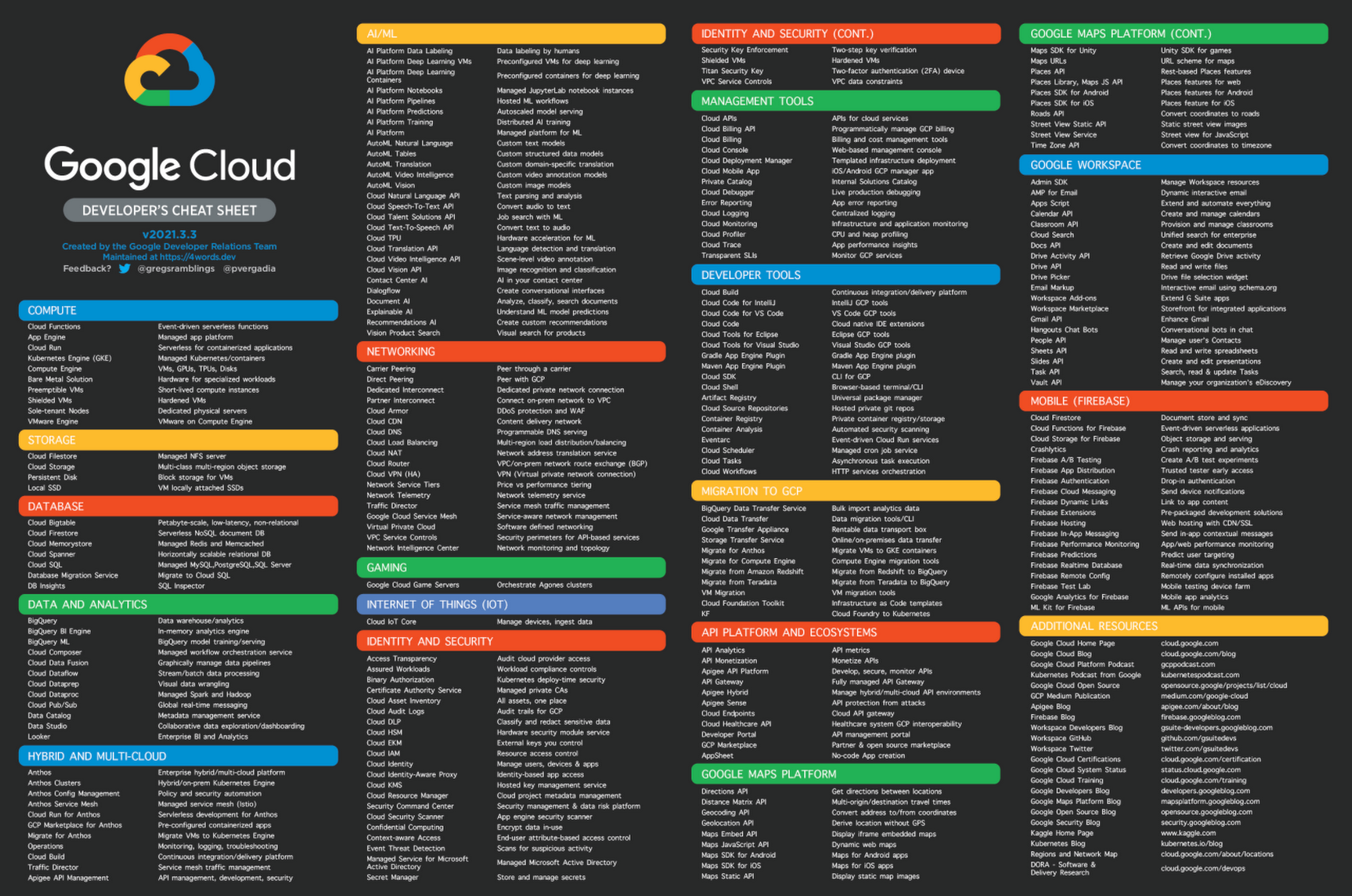

Let me know what you think of our new resources! You can find me on Twitter at @stephr_wong.
